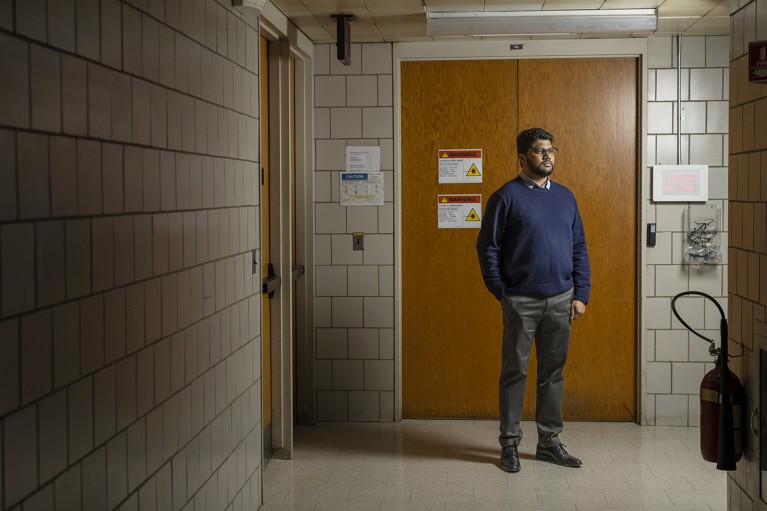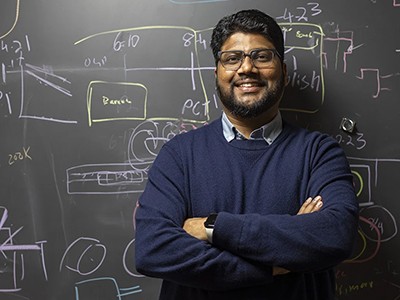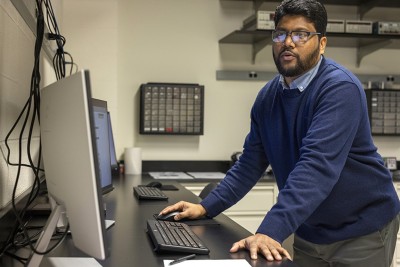
Ranga Dias is no longer employed as a researcher at the University of Rochester in New York, but continues to work at his company nearby, Unearthly Materials.Credit: Lauren Petracca/New York Times/Redux/eyevine
Ranga Dias, a once bright star in the field of superconductivity who has been enmeshed in a public scandal for the past two years, is no longer employed by his university.
Exclusive: official investigation reveals how superconductivity physicist faked blockbuster results
Dias claimed to have discovered superconductors — materials in which electrons flow without any resistance — that could operate at high pressures and ambient temperatures. Previous materials of this type worked only at ultralow temperatures impractical for use in real-world devices. The purported breakthroughs shot Dias to fame and won him millions of dollars in research grants. But after physics sleuths scrutinized the extraordinary results and reported concerns to journals where they were published, several of Dias’s papers were retracted. And an investigation by the University of Rochester in New York, where Dias was employed, concluded that he had committed extensive misconduct, including data fabrication.
The Wall Street Journal and Nature’s news team previously reported that university administrators recommended Dias, who did not have tenure, be fired before his contract expired in June 2025. Now, Dias is out, although the university has declined to clarify whether he was fired. “Ranga Dias is no longer a University of Rochester employee, nor does he have any research activity connected to the University,” a university spokesperson said in a statement. Dias did not respond to a request for comment.
The Dias scandal cast a shadow over the field of high-pressure superconductivity, but it particularly affected his former graduate students, who commented to Nature but requested anonymity because of concerns about their careers. “I am relieved that we finally have closure on this matter, though very disappointed it took so long,” one says. They added that they “await a public statement from the University of Rochester outlining what policies failed”, allowing the controversy to go on for as long as it did.
A Rochester spokesperson says that the university supports students “impacted by the research misconduct of Ranga Dias” and that it is “reviewing and updating our research misconduct policy”.
Under investigation
Dias joined Rochester as a professor in 2017, fresh from a postdoctoral fellowship at Harvard University in Cambridge, Massachusetts, where he claimed to have produced metallic hydrogen. In theory, when hydrogen is compressed to pressures greater than that at Earth’s centre, it should transform from an insulating gas to a superconducting metal. The results were never reproduced, and many scientists doubted it.
Nature retracts controversial superconductivity paper by embattled physicist
At Rochester, Dias turned his eye to other high-pressure superconductors. In September 2020, he published a breakthrough study in Nature1, which claimed that a compound made of carbon, sulfur and hydrogen (CSH) is a superconductor at room-temperature. And in March 2023, he published another in Nature2 finding that a compound of lutetium, hydrogen and nitrogen is a room-temperature superconductor at pressures 100 times lower than CSH — conditions even more practical for commercial use. (Nature’s news team is editorially independent from its journals team.)
After the first paper was published, Dias’s star rose and Rochester doubled his salary. At the same time, Jorge Hirsch, a theorist at the University of California, San Diego, raised questions that led to three inquiries at the university. None found evidence of misconduct, however. Nature’s journal editors meanwhile retracted the CSH paper after they conscripted independent specialists to review it, and those specialists found evidence of data fabrication.
Data in the 2023 paper also raised questions in the research community, and Dias’s former graduate students contacted Nature that year with concerns about the validity of the results. It was retracted that November.
One sleuth, James Hamlin, a high-pressure physicist at the University of Florida in Gainesville, brought his concerns to the National Science Foundation (NSF), a major funder of science in the United States that awarded grants to Dias. Ordered by the NSF, Rochester launched a full misconduct investigation.
Three external investigators commissioned by the university found that Dias more likely than not committed research misconduct in 16 out of 16 allegations that they examined. Public records from the NSF show that an approximately US$800,000 grant awarded by the agency to Dias was cancelled after the investigation concluded.
Researchers shared their thoughts about Dias’s departure from Rochester with the news team. “Did the system work?” says Peter Armitage, a condensed-matter researcher at Johns Hopkins University in Baltimore, Maryland. “Yes, eventually, but many institutions failed us along the way.” He points to Rochester for having missed problems in those early inquiries and Nature for having published a second paper by Dias after the first retraction.
Nature‘s journals team declined to comment.
Case closed?
Dias has insisted on the validity of his superconductivity research on social media, but he has published no further evidence supporting it. And independent teams have not replicated the results since Rochester’s investigation results were made public. In June, another of Dias’s papers, this one published by the journal Physical Review Letters and claiming to create another high-temperature, high-pressure superconductor, was retracted3. This brings his total retractions to five.
What Dias will do now remains unclear, but according to reporting from the Rochester Democrat and Chronicle, Dias continues to work at Unearthly Materials, his Rochester-based company that aims to make novel superconductors. In 2022, the company received $15 million in funding from the venture capital group Plural, based in London. A spokesperson for Plural declined to comment on Dias’s misconduct, and after receiving questions from the Nature news team for this story, references to Dias disappeared from the company’s website.
Disclosure: The author of this story is related to Robert Garisto, the managing editor of Physical Review Letters. The two have had no contact about this story.




